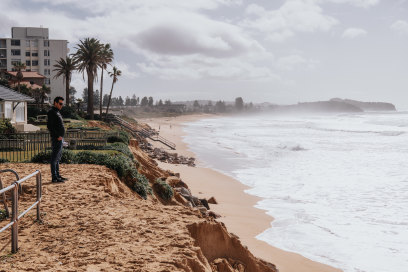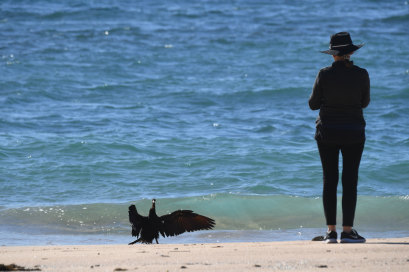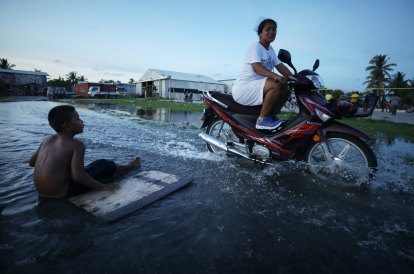Australia is already 1.5 degrees hotter
By Bianca Hall
Australia’s average temperatures have risen by 1.5 degrees for the first time since records began, and the world is on track to overshoot the Paris Accord’s aim to limit global warming to 1.5 degrees.
That’s the latest sobering assessment offered by scientists and meteorologists from the CSIRO and Bureau of Meteorology, who have mapped Australia’s changing climate for 14 years.

Rising sea levels are causing coastal erosion, like that seen in August on Collaroy and Narrabeen beach.Credit: James Brickwood
Their latest biennial State of the Climate report, released on Thursday, shows average temperatures continue to rise steadily, while the average number of extreme bushfire days have risen by as many as 25 days a year in parts of the country.
Two years ago, Australia’s temperatures had risen by an average 1.47 degrees since records began in 1910. This year, average temperatures in Australia have risen by 1.5 degrees, while global averaged temperatures have risen by 1.2 degrees since “reliable” records began in 1850.
“Globally we’re at about 1.2 degrees because that encapsulates the surface air temperature just above the sea level, but Australia and other land masses are at around 1.5 degrees because the land heats more quickly than the water,” Dr Jaci Brown, climate research manager at the CSIRO said.
Scientists have repeatedly said Earth would need to average 1.5 degrees of warming over two or three decades to be in technical breach of the Paris threshold.

Australia’s climate has risen by an average 1.5 degrees since 1910.Credit: Dion Georgopoulos
The Intergovernmental Panel on Climate Change warned in 2018 that even if global temperatures were limited to a 1.5 degree rise on pre-industrial levels, seas would rise by .4 metres.
“It’s looking increasingly unlikely that we’ll be able to stop at 1.5 degrees,” Brown said. “[More likely], there’ll be an overshoot and we’ll have to try to bring it back.”
Here are the key takeaways from the report.
The sea is heating, too

Nine of the 10 warmest years on record for our oceans have taken place since 2010.Credit: Peter Rae
Sea surface temperatures have risen by an average 1.08 degrees since 1900. Dr Karl Braganza, national manager of climate services at the bureau, said the value of mapping Australia’s changing climate over 14 years was scientists could demonstrate the changes were greater than climatic variability.
“When we look at the most significant sea surface temperature changes, they tend to be along the east coast, particularly down in the Tasman off the coast of southern NSW, Victoria and Tasmania,” he said.
“So we’re seeing an increased transport of heat from the north to the south through the east Australia current, and that’s associated with quite significant ecosystem changes. So we’re seeing tropical fish and other warm water marine organisms appear further south than we once used to, and that’s quite noticeable to the fisheries and scientists.”
We’re creating optimal bushfire conditions
While year-to-year climactic conditions influence how much fuel is available and how dry it is, the CSIRO and the Bureau report there is clear evidence extreme fire weather is more common, and fire seasons have become more extreme, since 1950.
Some parts of Australia, including on the east and west coast, experience 25 more dangerous bushfire weather days each year compared with 1950.

“The numbers hide the trauma,” says Serena Joyner, chief executive of Bushfire Survivors for Climate Action.
“We’re getting into spring and summer with a drier landscape than we once saw, and then once the season starts, we’re seeing fire weather that is both more extreme than the past and more frequent than the past,” Braganza said.
Bushfire Survivors for Climate Action chief executive Serena Joyner said for bushfire survivors, reports like this represent more than data points and scientific modelling.
“The numbers hide the trauma,” she said. “It isn’t a surprise … the bushfire seasons are getting longer, they’re getting more severe, and our members greet these kinds of reports with a sinking despair.”
Our rainfall patterns have changed
Rainfall in the south-west of the country has fallen by about 20 per cent during the colder months of May to July since 1970, and by 16 per cent from April to October across the same region.
April to October rainfall in the south-east of Australia has decreased by about 9 per cent since 1994, but heavy short-term bursts of rainfall are becoming more intense.
Meanwhile, scientists have observed a decrease in the number of tropical cyclones in Australia’s region since at least 1982.
Sea levels are rising

A woman rides her scooter through floodwater in Tuvalu’s capital, Funafuti, in November 2019.Credit: Getty Images
Global sea level rises vary from year to year, but teams from the CSIRO and the bureau report there has been a global mean sea level rise of more than 22 centimetres since 1900. Half of this increase has taken place since 1970.
Pacific leaders have called on the international community to limit warming to “1.5 to stay alive”.
Climate Change and Energy Minister Chris Bowen said the report “reiterates the urgent need to act on climate change”.
“Only the Albanese government has a credible plan to act on climate change.”
Get to the heart of what’s happening with climate change and the environment. Sign up for our fortnightly Environment newsletter.